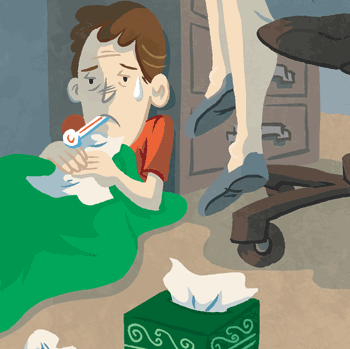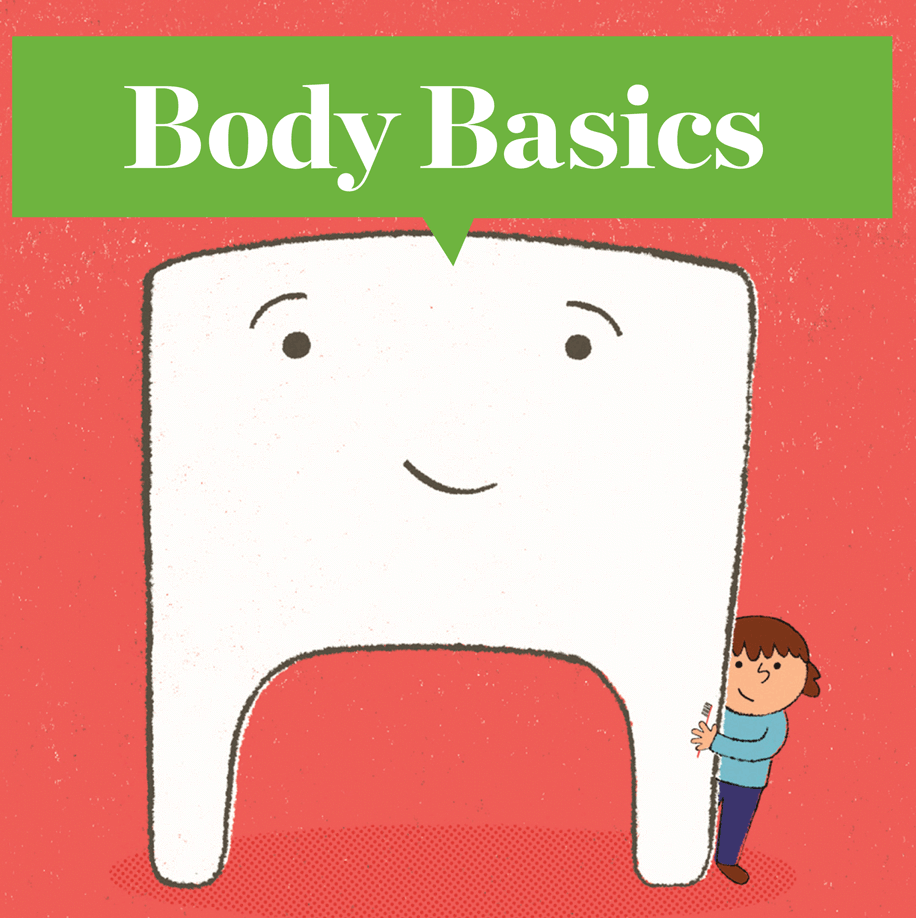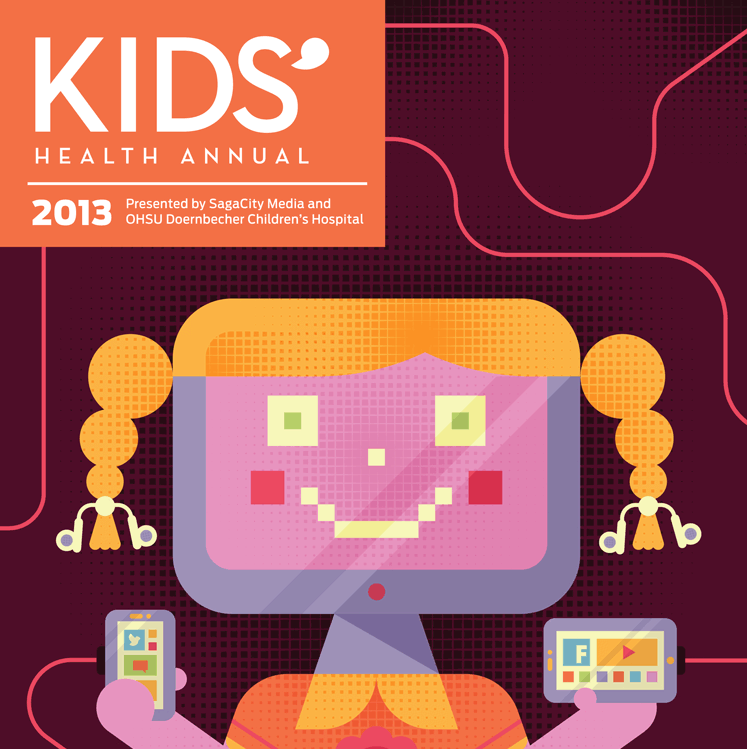Technology & Children's Health

Image: Luke Bott
In some circles, technology has gotten a pretty bad rap—smartphones, video games, movies, and TV have been blamed for everything from rising levels of childhood obesity and ADD/ADHD to sleep disorders, classroom temper tantrums, and risky adolescent sexual behaviors. But technology serves a positive purpose, too: sending a child out of the house with a cell phone in hand and Mom’s number on speed-dial calms the nerves of many a parent. Kids are asked to do their homework on computers increasingly often, and are no longer limited to the research they can do in their school library. And whether we like it or not, much of the crucial social development that used to take place on the school playground has migrated to Facebook walls and Twitter feeds.
News headlines lament the loss of a “real human connection,” while others celebrate the new opportunities for communication and collaboration offered by media and technology. “There are a lot of people in this discussion with very strong opinions,” says Darren Janzen, a pediatric psychologist at OHSU’s Doernbecher Children’s Hospital and a father of two. “But it’s not going away. We can’t fear technology, but we can be mindful of it, and we can decide how our kids will interact with it.”
“Background media use—that is, parents’ consumption of media—distracts them from interacting with their children.”
This isn’t to say there aren’t serious concerns to address. Managing the role that technology use plays in rising child obesity levels is a difficult job for parents of kids who would rather exercise their thumbs on a video game controller than kick a soccer ball around outside. “Obesity is complicated, but at some level it’s calories coming in versus calories going out—and if kids aren’t active, they’re falling behind,” explains Carrie Phillipi, a pediatrician at OHSU Doernbecher and a mother of four. She encourages parents to advocate for recess and free-play at their children’s schools, where children can get the person-to-person social interaction and the physical exercise they need.

Image: Luke Bott
Attention deficit disorders have been a hot-button issue for parents, politicians, and pediatricians for years, including rising worries about the relationship between technology use and these health issues. “Access to media doesn’t cause ADHD—the vast majority of these cases are related to genetics,” Dr. Janzen explains. “But because ADHD is a deficit of self-regulation, kids with it can get sucked into TV and video games much more intensely than other kids can. It’s not causing the disorder, but there can certainly be greater challenges in pulling away from media and moving to other important activities.”
While overexposure to media may not cause clinical attention disorders, it can breed attention-jumping habits. Rather than learning to focus on one task or subject for a long period of time, kids can jump from video to video on YouTube, or scroll through a Facebook feed looking for an interesting snippet of entertainment. “Too much media time may take away from the practice of other important skills or activities,” Dr. Janzen says.
Parenting a child in an increasingly technology-saturated world means navigating the ins and outs of rapidly changing communication devices, social media sites, and entertainment options. Restricting access to age-inappropriate material, limiting time spent parked in front of a TV (or smartphone, computer, or tablet), and limiting where and when they access those screens are all crucial aspects of fostering children’s healthy relationship with new media and technology. What, where, when, and how much media kids should consume is hotly debated by technology advocates and adversaries—but pediatricians are on the front line, dispensing useful advice to curious and concerned parents.
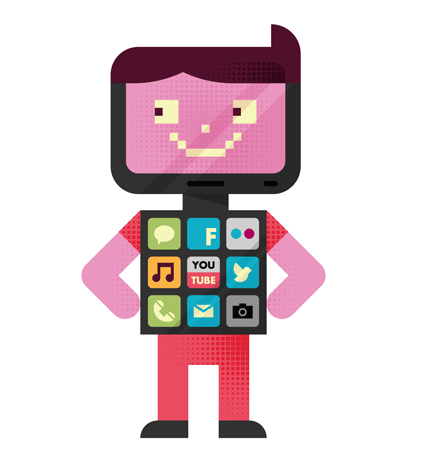
Image: Luke Bott
START SLOW
Today’s children spend an average of seven hours a day tuned in to some kind of entertainment media—televisions, computers, and smartphones are virtually unavoidable, from the screens lining the walls at some restaurants and retail stores to the new computers appearing in grade school classrooms every year. While some exposure to media is unavoidable, parents should be in control of the bulk of the time their children spend engaging with technology.
For children under 2, doctors recommend no screen time at all. Sorry, parents—this means no “Baby Einstein,” either. “Infants and young children learn by playing and interacting with humans, not screens,” says Dr. Phillipi. But keeping young kids away from screens is only half the battle. It’s especially important in these early stages of development for parents to unplug from their own devices. “Background media use—that is, parents’ consumption of media—distracts them from interacting with their children,” she says.
After 2 years of age, doctors recommend a maximum of two hours of digital media a day, a guideline echoed by the American Academy of Pediatrics. “This can be hard to follow, though, especially as kids are asked to do more of their schoolwork on the computer,” says Dr. Janzen. “I usually start by encouraging parents to limit kids to two hours of media for entertainment purposes, outside of what’s needed for school.”
Even when media access is carefully controlled at home, kids may have additional exposure elsewhere. Communicating with children, their friends, teachers, and other adults in their lives about the activities that take place when parents aren’t present can provide a clearer snapshot of their actual media consumption.
CONTENT IS KEY
After their children are 2, parents should be vigilant about small doses of age-appropriate media. “With young kids, it is best when content is slower-paced, sends a pro-social message, and is educational in some way,” Dr. Janzen says.
“Content is a big concern for me,” says Dr. Phillipi. While the cool factor of on-screen smoking has been tarnished by the aggressive campaigning of anti-tobacco groups, that still leaves the violence, sexual promiscuity, and other risky behaviors that feature prominently on popular TV shows, websites, and video games. She counsels parents to communicate very clearly and directly about inappropriate media use, and to familiarize themselves with the content and storylines of their kids’ favorite shows and games.
There are rating systems in place for movies and video games, which can serve as helpful guidelines for what may or may not be appropriate for your child. “But don’t take their word for it—just because a movie is rated PG-13 doesn’t mean your 13-year-old is ready for it,” Dr. Janzen says. “Similarly, some kids can handle content rated slightly above their age level when appropriate guidance and oversight is provided.”
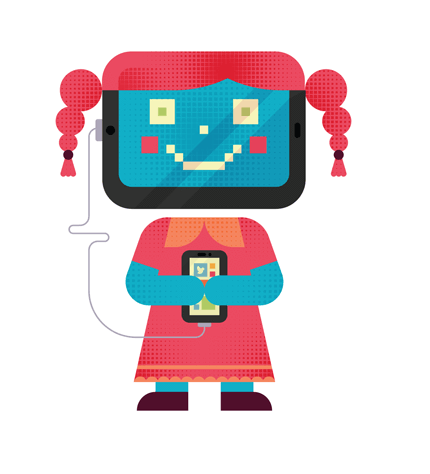
Image: Luke Bott
LEAD BY EXAMPLE
An easy way to demonstrate healthy interaction with technology is to set rules for common areas of the house that all family members have to follow. “No phones at the dinner table, no checking your e-mail while you help with homework,” says Dr. Phillipi. Watching TV with one eye and a third-grader practicing handstands with the other means both your favorite show and your gymnast-in-training aren’t getting the attention they deserve.
It may seem simple, but parents should be wary of the content they watch while kids are in the room. Even if they’re busy with another activity, kids who aren’t ready for “grown-up” jokes and plotlines can easily misinterpret the snippets of information they pick up.
Watching shows and movies as a family is an easy way to enjoy time together, while keeping watch on the ways kids react to different types of content. If themes or issues are presented that kids respond negatively to or have questions about, parents can address them right away.
SCREEN-FREE ZONES
Designating “screen-free zones” in the house can also help a parent keep track of the time kids spend with their devices, and what kind of content they consume. Dr. Phillipi recommends setting up a computer for doing homework in the living room or kitchen, where parents are likely to pass by often.
“It is important to consciously reward good behaviors in our children, rather than giving in to bad ones.”
For children of all ages, it’s important to cut off screen time at least an hour before bed. Set up phone chargers outside of the bedroom, so kids and teens aren’t awakened in the middle of the night with a text from a friend (or tempted by the sudden urge to post a photo of their footie pajamas on Instagram).

Image: Luke Bott
STRIKING A BALANCE
Dr. Janzen is no stranger to temptation. When his kids’ energy levels are a little too high to be safely contained inside a moving vehicle, the flip-down TV screen in the backseat looks better by the minute. “Doctors struggle with the same things everyone else does,” he says. He advises parents to set clear and consistent rules for technology use, and follow them whenever possible, to make saying “no” easier—even in the middle of a full-blown temper tantrum.
Sometimes, though, long-term parenting goals have to yield to surviving a trip to the grocery store—and that’s OK. “We try to save screens in the car for long rides, not short trips around town,” Dr. Janzen says. “Every once in a while, these things are
nice to have. However, it is important to consciously reward good behaviors in our children, rather than giving in to bad ones.”
For better or for worse, much of the younger generation’s social development is wrapped up in media. Complex social interactions take place on Facebook, and profound personal revelations are shared on Twitter. Kids who are completely cut off from social media and other technologies may have trouble relating to their peers, or keeping up with conversations.
Walking the line between too much media, not enough media, the right kinds of media, and media in the right places, at the right times, is a big job—but one that, if managed carefully, can ultimately benefit the entire family.
“Technology isn’t all bad,” says Dr. Phillipi. “My daughter just left for college, and it’s great being able to talk or text with her regularly. We use technology to connect as a family, and I love that.”
For more on raising active kids in a tech-heavy world, check out
the Healthy Families blog from OHSU Doernbecher experts.
